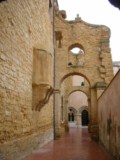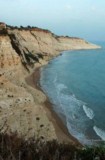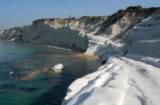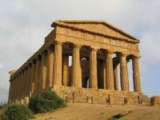|
AGRIGENTO - SICILY - SOUTH ITALY Located on a plateau overlooking Sicily's southern coast, Agrigento was founded as Akragas around 582 BC by a group of colonists from Gela, who themselves were the immediate descendants of Greeks from Rhodes and Crete. Akragas was renamed Agrigentum by the Romans, and Girgenti by the Saracens, only to be christened Agrigento in 1927.
The Greek temples, theatres and ruins, and even the archaeological museums, are located outside the city. Agrigento was destroyed several times during the Punic Wars, suffering particularly extensive damage during a siege by Roman forces in 261 BC, but always rebuilt. The Greek poet Pindar (518-438 BC) described Akragas as "the most beautiful city of the mortals." Akragas' most famous citizen was the philosopher and scientist Empedocles (490-430 BC). In the Valley of the Temples are the ruins of numerous temples but also Necropoli's houses, streets and everything else one would expect to find in an ancient city. There is a small amphitheatre, as well as several auditoria, and a fine archeological museum. Most of the temples at Agrigento are in ruins, and several appear to have never even been completed. Part of the Temple of Juno, built around 450 BC, is still intact. Its style has been compared to that of the temples at Paestum, near Salerno. The Temple of Concord (named retroactively), built around 440 BC, is in far better condition, and at night the illuminated temple is a sight to behold. A number of telamons (large segmented stone columns in the form of human figures) have been preserved. Agrigento's importance declined under the Byzantines and Saracens, who encouraged settlement of the medieval city several kilometers from the Valley of the Temples. The Normans, however, recognized its importance, and it was during the Norman rule that beautiful churches were constructed in and around the city. Ancient Agrigento's architectural character seems more Greek than Roman, though the latter is certainly evident. What's missing are the thin bricks so typical of Roman sites like Solunto and Taormina. Despite its location virtually in the shadow of a modern city, the Valley of the Temples is surrounded by olive groves and almond orchards that render its ambience altogether natural, though a number of illegally-built houses mar the landscape. The almond blossom festival held in February is a spectacular event. The ruins of a Roman villa are located at an archeological site a few kilometers up the coast from Porto Empedocle. The birthplace of Luigi Pirandello, (1867-1937) a Nobel prize-winning author, is located in the tiny hamlet of Caos, where his house has been made a museum. |
||||||||














